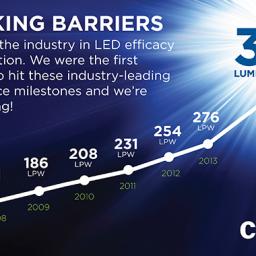More efficient new LEDs now available, over 200lm/W
 Cree's newly announced XP-G3 model of LED delivers 31% more lumens (lm) and 8% higher lm/W than its predecessor. Offering over 205 lm/W at 350mA, this marks the first time commercially-available LEDs have exceed the efficiency of low-pressure sodium lamps, commonly found in municipal streetlights. OrangeTeK has already announced they are designing a new model of streetlight with XP-G3 LEDs. In practice, however, it's likely that most users of XP-G3 LEDs will run them at higher power with reduced efficiency, rather than install five times as many LEDs, due to price. Any efficiency improvements are good news, however, as numerous cities have already installed LED streetlights, and many more have plans in the works. This seems to be motivated by the whiter appearance of LEDs compared to sodium lights, which is ironically the major source of opposition from the public, who complain about LED streetlights keeping them up at night, among other concerns.
Cree's newly announced XP-G3 model of LED delivers 31% more lumens (lm) and 8% higher lm/W than its predecessor. Offering over 205 lm/W at 350mA, this marks the first time commercially-available LEDs have exceed the efficiency of low-pressure sodium lamps, commonly found in municipal streetlights. OrangeTeK has already announced they are designing a new model of streetlight with XP-G3 LEDs. In practice, however, it's likely that most users of XP-G3 LEDs will run them at higher power with reduced efficiency, rather than install five times as many LEDs, due to price. Any efficiency improvements are good news, however, as numerous cities have already installed LED streetlights, and many more have plans in the works. This seems to be motivated by the whiter appearance of LEDs compared to sodium lights, which is ironically the major source of opposition from the public, who complain about LED streetlights keeping them up at night, among other concerns.Philips had previously demonstrated 200lm/W LEDs, and claimed they'd be available to consumers by 2015, but a search of current products only reveals far less-efficient models. The XP-G3 is available for order right now. Cree has previously demonstrated LEDs in the lab that deliver up to 303 lm/W, which is half-way to the maximum theoretical efficiency of this technology. Estimates are that as much as one quarter of the world's electrical consumption is used for lighting. Most consumers could see significant savings just by switching to florescent or LED lights in the first place. About 50 percent of lights sold in the US are halogen incandescents, which are only one quarter as efficient as LEDs, have far shorter operational lifetimes, and cost about one quarter as much.
And I've heard so many times the argument "LED consume less energy" touted that I actually believed LED were much more efficient than sodium lights already. Could it be possible that the people ordering all new lights to be LEDs incorrectly assume the same?